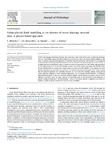Mostrar o rexistro simple do ítem
Urban pluvial flood modelling in the absence of sewer drainage network data: a physics-based approach
| dc.contributor.author | Montalvo Montenegro, Carlos Israel | |
| dc.contributor.author | Reyes-Silva, Julián David | |
| dc.contributor.author | Sañudo, Esteban | |
| dc.contributor.author | Cea, Luis | |
| dc.contributor.author | Puertas, Jerónimo | |
| dc.date.accessioned | 2024-03-13T16:22:52Z | |
| dc.date.available | 2024-03-13T16:22:52Z | |
| dc.date.issued | 2024 | |
| dc.identifier.citation | Montalvo, C., Reyes-Silva, J. D., Sañudo, E., Cea, L., Puertas, J. (2024). Urban pluvial flood modelling in the absence of sewer drainage network data: A physics-based approach. Journal of Hydrology, 131043. https://doi.org/10.1016/j.jhydrol.2024.131043 | es_ES |
| dc.identifier.uri | http://hdl.handle.net/2183/35877 | |
| dc.description | Financiado para publicación en acceso aberto: Universidade da Coruña/CISUG | es_ES |
| dc.description.abstract | [Abstract:] 1D/2D dual drainage models have become one of the most useful tools in the study of urban pluvial floods. However, such models require information about the sewer network that is not always readily available. In this study we present a physics-based approach for assessing urban pluvial floods, with the aim of overcoming the common situation of having limited information on the sewer system. The method proposed involves the use of available open-access information within a virtual sewer network generation tool. This realistic approach allows for the implementation of 1D/2D dual drainage models, such as the recently developed Iber-SWMM model. Results obtained from four storm events using a virtual sewer network in Iber-SWMM were compared with those derived using data from the actual sewer network in a coastal town located in NW Spain. These results revealed that the proposed approach can reasonably represent the sewer network's drainage capacity during pluvial floods, especially compared to other simplified approaches, like the rainfall reduction method. The proposed approach also accounts for the sewer network transport capacity and the impact of overflows when a sewer’s capacity is exceeded. Hence the study confirms the significant effect of these processes on the magnitude of pluvial flooding in urban areas. The methodology is shown to be robust, and can be applied to any urban settlement in which no proper record of the sewer network is available. | es_ES |
| dc.description.sponsorship | This project has received financial support from the Spanish Ministry of Science and Innovation (MCIN/AEI/10.13039/501100011033) within the project “SATURNO: Early warning against pluvial flooding in urban areas” (PID2020-118368RB-I00) and the FPI predoctoral grant from the Spanish Ministry of Science, Innovation, and Universities (PRE2021-098425). Funding for open access charge: Universidade da Coruña/CISUG. | es_ES |
| dc.language.iso | eng | es_ES |
| dc.publisher | Elsevier | es_ES |
| dc.relation | info:eu-repo/grantAgreement/AEI/Plan Estatal de Investigación Científica y Técnica y de Innovación 2017-2020/PID2020-118368RB-I00/Sistemas de alerta temprana frente a inundaciones pluviales en entornos urbanos | es_ES |
| dc.relation | info:eu-repo/grantAgreement/AEI/Plan Estatal de Investigación Científica y Técnica y de Innovación 2021-2023/PRE2021-098425 | es_ES |
| dc.relation.uri | https://doi.org/10.1016/j.jhydrol.2024.131043 | es_ES |
| dc.rights | Atribución-NoComercial-SinDerivadas 3.0 España | es_ES |
| dc.rights.uri | http://creativecommons.org/licenses/by-nc-nd/3.0/es/ | * |
| dc.subject | Urban pluvial flooding | es_ES |
| dc.subject | Dual models | es_ES |
| dc.subject | Iber | es_ES |
| dc.subject | SWMM | es_ES |
| dc.subject | Data scarcity | es_ES |
| dc.title | Urban pluvial flood modelling in the absence of sewer drainage network data: a physics-based approach | es_ES |
| dc.type | info:eu-repo/semantics/article | es_ES |
| dc.rights.access | info:eu-repo/semantics/openAccess | es_ES |
| UDC.journalTitle | Journal of Hydrology | es_ES |
| UDC.volume | 634 | es_ES |
| UDC.startPage | 131043 | es_ES |
| dc.identifier.doi | 10.1016/j.jhydrol.2024.131043 |






